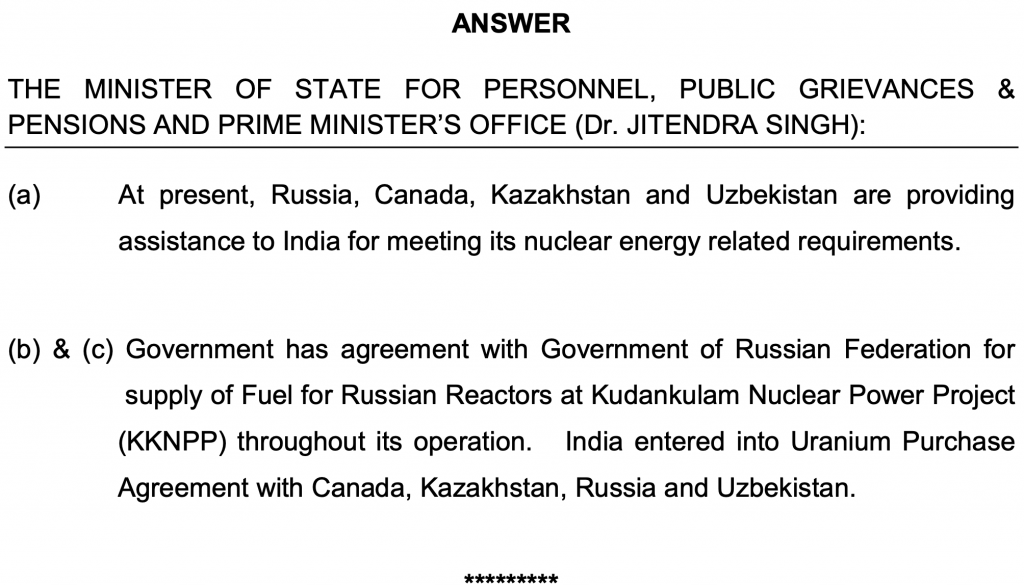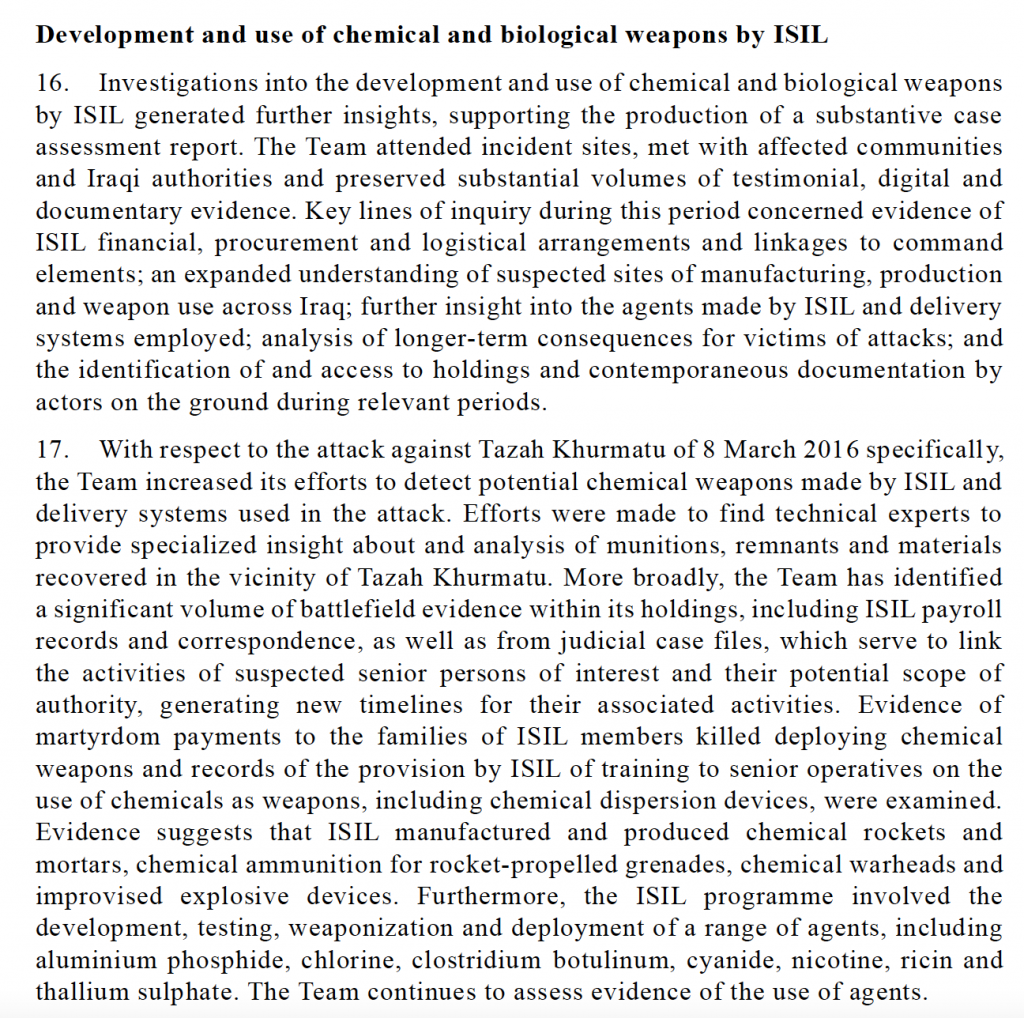India’s DAE on foreign assistance:


India’s DAE on foreign assistance:

It’s been a while, but here’s a November report from the UN Investigative Team to Promote Accountability for Crimes Committed by Da’esh/Islamic State in Iraq and the Levant. It contains new information about ISIL’s “development and use of chemical and biological weapons.”
Chemical weapons:
Evidence suggests that ISIL manufactured and produced chemical rockets and mortars, chemical ammunition for rocket-propelled grenades, chemical warheads and improvised explosive devices. Furthermore, the ISIL programme involved the development, testing, weaponization and deployment of a range of agents, including aluminium phosphide, chlorine, clostridium botulinum, cyanide, nicotine, ricin and thallium sulphate.
A longer excerpt:

Late, but not sure many people have read this part of the final document from the MSP.
While the Treaty is a stand-alone legally binding instrument, it builds upon, contributes to and complements a rich and diverse disarmament and non-proliferation architecture. In order to highlight and underscore these complementarities with specific disarmament instruments, particularly the Non-Proliferation Treaty, States parties resolve:
Action 35: To emphasize the complementarity of the Treaty with the existing disarmament and non-proliferation regime at appropriate opportunities, including preparatory meetings and review conferences of the Non-Proliferation Treaty, and with relevant multilateral nuclear disarmament-related initiatives and groupings.
Action 36: To appoint an informal facilitator or facilitators to further explore and articulate the possible areas of tangible cooperation between the Treaty and the Non-Proliferation Treaty during the intersessional period, and provide support for the efforts of the informal facilitator or facilitators.
Action 37: To cooperate with other international bodies, such as the International Atomic Energy Agency and the Preparatory Commission for the Comprehensive Nuclear-Test-Ban Treaty Organization, in order to enhance cooperation, including in the areas of nuclear safeguards and verification. Such cooperation should enhance the complementarity between the Treaty, the Non- Proliferation Treaty and the Test-Ban Treaty.
Action 38: To continue to work together on outreach projects in order to raise awareness, not only among Governments, but also with civil society, academia, parliamentarians and the general public, including youth organizations, so as to highlight the complementarity between the Treaty and the existing disarmament and non-proliferation regime, including nuclear-weapon-free zone treaties.
From VICE:
From a recent statement to the OPCW Conference on State Parties:
Israel actively participated in the negotiations and signed the CWC in 1993, as a sign that it shares the values, norms and goals that the Convention represents and promotes. It is important to note that Israel also acceded to the 1925 Geneva Protocol, adheres to export control regimes, including the Australia Group, and traditionally supports the United Nations General Assembly CWC First Committee resolution. We hope that others in the region who have not done so yet will join the CWC as a testament of their commitment to the norms and values it represents.
May be old news, but this EU regulation contains descriptions of three entities involved in Syria’s chemical weapons program.
Mohammad Nazier Houranieh is the co-owner of MHD Nazier Houranieh & Sons Co company, which operates in the metals industry and supplies the Syrian Studies and Research Centre (SSRC) with materials used in the manufacture of chemical weapons delivery systems. Therefore, Mohammad Nazier Houranieh is responsible for providing material support for manufacturing chemical weapons and is engaged in preparations for the use of chemical weapons and thus contributes to the continued threat posed by the proliferation and use of chemical weapons.
Chadi Houranieh is the co-owner of MHD Nazier Houranieh & Sons Co company, which operates in the metals industry and supplies the Syrian Studies and Research Centre (SSRC) with materials used in the manufacture of chemical weapons delivery systems. Therefore, Chadi Houranieh is responsible for providing material support for manufacturing chemical weapons and is engaged in preparations for the use of chemical weapons and thus contributes to the continued threat posed by the proliferation and use of chemical weapons.
MHD Nazier Houranieh & Sons Co is a company operating in the metals industry and supplies the Syrian Studies and Research Centre (SSRC) with materials used in the manufacture of chemical weapons delivery systems. Therefore, MHD Nazier Houranieh & Sons Co provides material support for manufacturing chemical weapons and is engaged in preparations for the use of chemical weapons and thus contributes to the continued threat posed by the proliferation and use of chemical weapons.
A reader provided a useful comment to this post:
Almost certainly because the secretary of state for defence isn’t involved ex-officio; the prime minister selects the two nuclear deputies at her own discretion. One of them usually is the defence secretary but this is not a binding condition.
From this October speech to the First Committee:
As a responsible nuclear weapon State, India is committed as per its nuclear doctrine, to maintain credible minimum deterrence with the posture of no-first use and non-use against non-nuclear weapon States.
Without diminishing the priority we attach to nuclear disarmament, India supports the immediate commencement of negotiations in the CD of a Fissile Material Cut-off Treaty on the basis of CD/1299 and the mandate contained therein. We share the widely felt disappointment that these negotiations continue to remain blocked.
From this press release:
Shri Rajnath Singh reiterated India’s position on the need to pursue the path of dialogue and diplomacy for an early resolution of the conflict. He pointed out that the nuclear option should not be resorted to by any side as the prospect of the usage of nuclear or radiological weapons goes against the basic tenets of humanity.